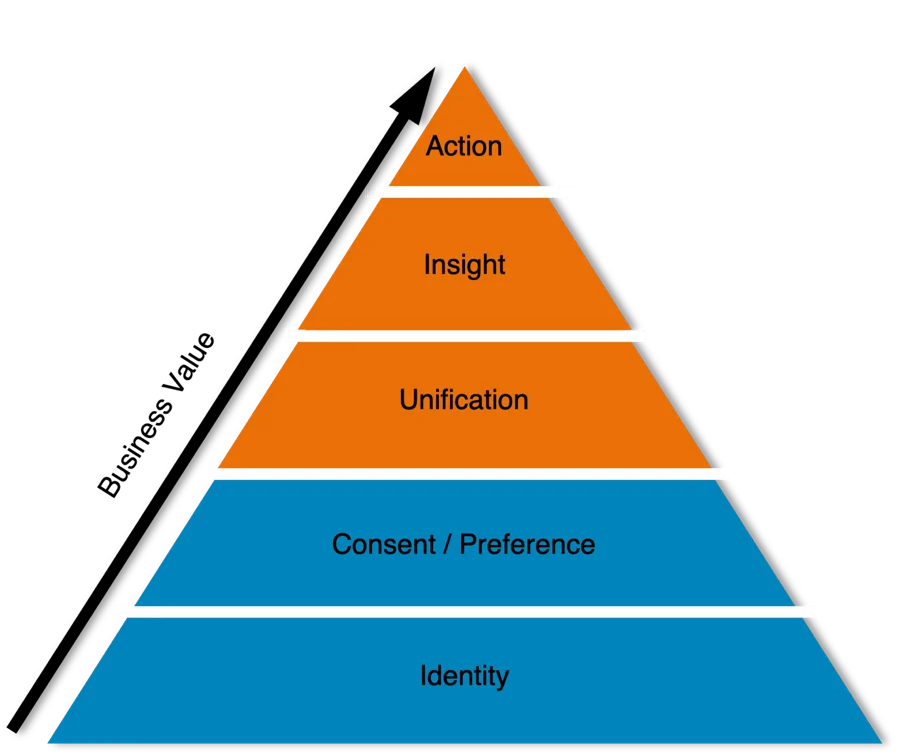A customer data platform (CDP) is not an end in itself
September 16, 2021

September 16, 2021

A 360-degree view of customers is so “yesterday.” What you really need is a context-sensitive view of the customer that allows you to react relevantly and immediately: At any point in the customer journey, at any time, across any channel, whether the customer initiates an interaction or whether you initiate it. Therefore, it’s important that the customer voluntarily and explicitly provides information. This significantly reduces the assumptions underlying segmentation algorithms and dramatically increases the accuracy of your actions and responses. Of course, it’s important that you collect and maintain data, since you do not know what will be important to your customer at a later date.
So far, so good. The main question that arises is how this can be done technically. From the point of view of the process and the results, it looks easy: You just provide the customer with the right information or answers at the right time.
All you need is the appropriate systems, data, and a CDP, right? You have the data, and the systems too, so do we just need to add a CDP? Hold your horses! Unfortunately, it’s not that easy, because a customer data platform is not an end in itself.
We’ll start by asking what a customer data platform is. In short, my definition:
A customer data platform is software that creates persistent, consistent customer records. These records make it possible to align business processes with customers’ interests and goals.

The most important basis is the identity of the customer. The customer’s identity is the core around which the customer profile is built. Then there’s a consent and preference layer. Many CPD providers still forget this layer, but it’s critical because the consents determine for what purposes and under what circumstances a customer agrees to the collection and use of data. The preferences, which a customer states explicitly, spare state-of-the-art AI systems a lot of annoying guesswork. All of this increases the relevance of the information and offers you provide to your customers. If this sounds familiar, that’s because it’s actually the functionality that a CIAM (customer identity and access management) system provides. Every good CDP is based on a CIAM system.
The core of the CDP is then the unification into customer profiles and, where possible, the enrichment of these profiles of the customers identified with additional information. This is basically data management. By unifying customer data, this layer creates significant added value, which unfortunately is difficult to express in dollars and cents.
On the next level, things become interesting: Here, based on (real-time) segments, insights are generated that can be used by other applications. CDP begins to focus on execution by providing services relating to customer data. However, this is still a pull model.
The greatest business value is gained when the CDP can actively trigger actions in other applications. At this level, the full potential of a unified customer record can be realized. For example, if specific actions are executed correctly based on the customer’s data record, the probability of a purchase increases. The customer record can thus be used actively to achieve business results, including to increase sales.
Any solution, from segmentation to campaign management, personalization, real-time interaction management (RTIM) to customer journey orchestration, requires a stable core of customer data and can therefore often be used as the core of a CDP. All solutions analyze customer data and based on this, provide business activities of increasing quality. Many companies already have a system environment that covers many aspects of what a CDP offers. For these companies, this means they need to look at exactly what they want to achieve, and which functions they already have in their application portfolio before looking for additional software. Some of these functions may not be used or may not be used enough.
If this analysis shows that the required functions are already available as part of the existing software stack, there is no need to increase the complexity of the system environment by adding more software. Instead, it’s interesting to see how data flows and data schemes need to be changed to meet the requirements. This is, so to speak, the direct entry into the project.
If the functions aren’t available, then it’s time to look for the most appropriate CDP, bearing in mind that the existing functionality doesn’t necessarily have to be taken over by the new software. Here, the task is essentially software selection.
However, this task is complicated by the fact that the CDPI Industry Update from January 2021 counted more than 130 vendors (and I know at least one that is not listed there) – meaning that there are probably just as many providers operating under the radar. Nevertheless, the rule “think big – act small” applies. Look for a solution that fits into the existing system environment and meets the requirements for the foreseeable future, and don’t let anyone bamboozle you.
Your personal Customer Experience consultation
If you think this is a task that you can’t do on your own, get some help. It’s worthwhile!
Don't miss a thing.
Subscribe to our latest blog articles.